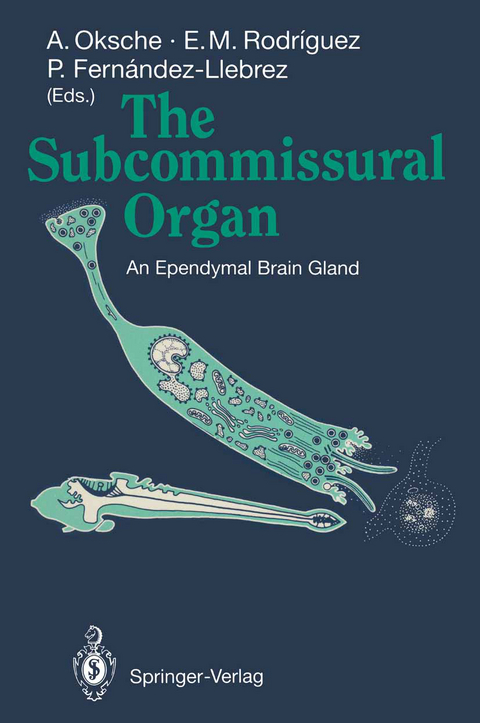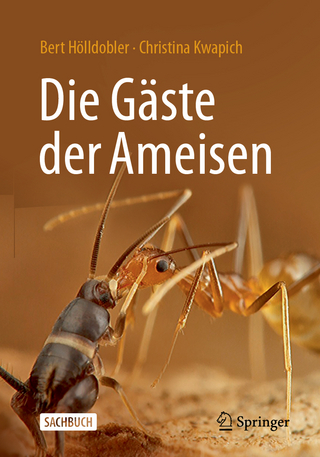
The Subcommissural Organ
Springer Berlin (Verlag)
978-3-642-78015-8 (ISBN)
I. Historical Reflections.- Ernst Reissner (1824-1878): Anatomist of the "Membrane" and "Fiber" (With 1 Figure).- Helmut Hofer (1912-1989) and the Concept of the Circumventricular Organs (With 1 Figure).- Historical Landmarks in the Investigation of the Subcommissural Organ and Reissner's Fiber (With 1 Figure).- II. Phylogeny and Ontogeny.- Phylogenetic and Conceptual Aspects of the Subcommissural Organ (With 3 Figures).- Reissner's Fiber Mechanisms: Some Common Denominators (With 3 Figures).- Ontogenetic Development of the Subcommissural Organ with Reference to the Flexural Organ (With 2 Figures).- Developmental Aspects of the Subcommissural Organ: An Approach Using Lectins and Monoclonal Antibodies (With 5 Figures).- The Subcommissural Organ and Ontogenetic Development of the Brain (With 5 Figures).- III. Biochemistry.- Protein Glycosylation in Mammalian Cells (With 3 Figures).- Partial Characterization of the Secretory Products of the Subcommissural Organ (With 3 Figures and 1 Table).- Biochemical and Immunochemical Analysis of Specific Compounds in the Subcommissural Organ of the Bovine and Chick (With 4 Figures and 3 Tables).- Immunochemical Analysis of the Dogfish Subcommissural Organ (With 2 Figures and 1 Table).- IV. Secretory Process, Including Model Systems.- Dynamic Aspects of the Secretory Process in the Amphibian Subcommissural Organ.- Evidence for the Release of CSF-Soluble Secretory Material from the Subcommissural Organ, with Particular Reference to the Situation in the Human (With 3 Figures).- The Subcommissural Organ In Vitro (With 2 Figures).- V. Relation to Other Circumventricular Organs: Conceptual Aspects.- Circumventricular Organs and Modulation in the Midsagittal Plane of the Brain (With 1 Figure and 1 Table).- Blood- and Cerebrospinal Fluid-Dominated Compartments of the Rat Brain (With 1 Figure).- VI. Neural Inputs.- The Subcommissural Organ of the Rat: An In Vivo Model of Neuron-Glia Interactions (With 2 Figures and 1 Table).- Neural Inputs to the Subcommissural Organ (With 2 Figures).- Impairment of the Serotoninergic Innervation of the Rat Subcommissural Organ after Early Postnatal X-Irradiation of the Brain Stem (With 2 Figures).- Immunocytochemistry of Neuropeptides and Neuropeptide Receptors in the Subcommissural Organ of the Rat (With 10 Figures).- VII. Connections with Other Brain Structures.- Relationships Between the Subcommissural Organ and the Pineal Complex (With 2 Figures).- The Goldfish Subcommissural Organ Is Not Innervated by Fibers of the Pineal Tract (With 2 Figures).- Immunochemical Relationships Between the Subcommissural Organ and Hypothalamic Neurons (With 6 Figures and 1 Table).- VIII. Physiology of the Cerebrospinal Fluid.- Cerebrospinal Fluid Secretion: The Transport of Fluid and Electrolytes by the Choroid Plexus (With 4 Figures).- Physiology of Cerebrospinal Fluid Circulation: Amphibians, Mammals, and Hydrocephalus (With 6 Figures and 1 Table).- IX. Experimental Aspects.- Effects of Hibernation and Hypothermia on the Secretory Activity of the Subcommissural Organ (With 3 Figures).- The Subcommissural Organ: Immunohistochemistry and Potential Relations to Salt/Water Balance (With 6 Figures and 1 Table).- Immunological Blockade of the Subcommissural Organ - Reissner's Fiber Complex (With 6 Figures).- The Effect of Immunological Blockade of Reissner's Fiber Formation on the Circulation of Cerebrospinal Fluid Along the Central Canal of the Rat Spinal Cord (With 4 Figures).- X. Discussion Sessions (With 3 Figures).- I Signal Pathways.- II Cell Biology and Biochemistry.- III Functional Aspects I.- IV Functional Aspects II.
| Erscheint lt. Verlag | 16.12.2011 |
|---|---|
| Zusatzinfo | XVI, 333 p. 7 illus. in color. |
| Verlagsort | Berlin |
| Sprache | englisch |
| Maße | 155 x 235 mm |
| Gewicht | 533 g |
| Themenwelt | Medizin / Pharmazie ► Studium |
| Naturwissenschaften ► Biologie ► Humanbiologie | |
| Schlagworte | biochemistry • brain • Cerebrospinal Fluid • Experiment • Glycoproteins • Hydrocephalus • Nature • neurons • Neuropeptides • New Experimental Models • Physiology • Secretory Ependyma • spinal cord • Subcommissural Organ-Reissner's Fiber Complex |
| ISBN-10 | 3-642-78015-6 / 3642780156 |
| ISBN-13 | 978-3-642-78015-8 / 9783642780158 |
| Zustand | Neuware |
| Haben Sie eine Frage zum Produkt? |
aus dem Bereich


